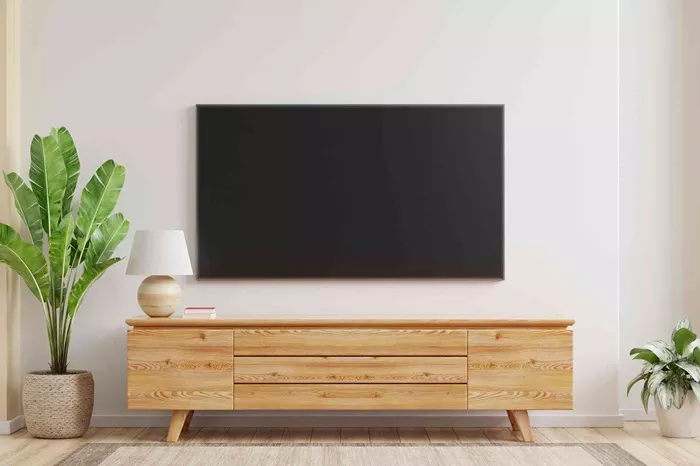Mounting a TV on drywall is a common practice, but it requires careful planning and proper technique to ensure safety and stability. Drywall alone is not strong enough to support the weight of a TV, so additional measures are necessary to secure the mount effectively. This guide will cover the considerations and steps about mounting a TV on drywall.
1. Understanding Drywall and Its Limitations
Description: Drywall, or gypsum board, is a popular building material used in many interiors due to its ease of installation and finish. However, drywall by itself is not capable of supporting heavy objects like TVs. This is because drywall is designed to cover and finish walls, not to bear substantial loads. Its structure consists of a layer of gypsum plaster sandwiched between two sheets of paper, making it relatively weak compared to other wall materials.
Explanation: To mount a TV on drywall, you need to anchor the mount into the underlying structure, typically the wooden or metal studs behind the drywall. These studs are designed to bear loads and provide the necessary support for mounting heavy items. Without proper anchoring, mounting a TV directly to drywall can lead to damage to the wall and potential safety hazards.
2. Locating and Using Wall Studs
Description: Wall studs are vertical framing members behind the drywall that provide structural support. They are typically spaced 16 or 24 inches apart, although this can vary. Finding and anchoring into these studs is crucial for securely mounting a TV. Using a stud finder is the most reliable method to locate these studs accurately.
Explanation: A stud finder is an electronic tool that detects changes in wall density, helping you identify the location of studs behind the drywall. Once located, you should use screws or bolts to attach the TV mount to these studs. This ensures that the weight of the TV is distributed across the stronger parts of the wall, providing a secure and stable installation.
3. Types of TV Mounts and Their Requirements
Description: There are various types of TV mounts, each with different installation requirements. The main types include fixed mounts, tilting mounts, and full-motion mounts. Each type has specific characteristics regarding how it attaches to the wall and adjusts the position of the TV.
Explanation
Fixed Mounts: These mounts hold the TV close to the wall without any adjustment capabilities. They require secure attachment to the studs and are ideal for fixed viewing angles.
Tilting Mounts: Allow for vertical adjustment of the TV angle, useful for reducing glare. They also need to be anchored to the studs for proper support.
Full-Motion Mounts: These mounts offer the most flexibility, allowing for adjustments in both horizontal and vertical planes. Due to their complexity and movement, they require robust mounting into the studs to ensure stability.
See also: How To Board Up A Window?
4. Tools and Materials Needed
Description: Proper installation of a TV mount requires specific tools and materials to ensure a secure and safe setup. Common tools include a drill, screwdriver, stud finder, level, tape measure, and appropriate mounting hardware.
Explanation
Drill: For making holes in the drywall and studs.
Screwdriver: For securing screws and bolts.
Stud Finder: To locate the studs behind the drywall.
Level: To ensure the TV mount is installed evenly.
Tape Measure: For accurate measurements of placement.
Mounting Hardware: Includes screws, bolts, and anchors appropriate for the TV mount and wall type.
5. Step-by-Step Installation Process
Description: The process of mounting a TV on drywall involves several key steps to ensure a secure and stable installation. Here’s a general guide:
Explanation
Locate the Studs: Use a stud finder to identify the location of the studs behind the drywall.
Mark the Mounting Points: Measure and mark the positions on the wall where the mount will be attached, ensuring alignment with the studs.
Drill Pilot Holes: Drill holes into the studs at the marked locations. Use a drill bit slightly smaller than the screws you’ll be using to ensure a tight fit.
Attach the Mount: Secure the TV mount to the wall using screws or bolts, ensuring it is level and firmly attached to the studs.
Hang the TV: Follow the mount manufacturer’s instructions to attach the TV to the mounted bracket.
See also: How To Read A Tape Measure In Millimeters (Mm): A Detailed Guide
6. Safety Considerations
Description: Ensuring the safety of the installation is paramount to prevent accidents and damage. Proper mounting techniques and hardware are essential to avoid potential hazards.
Explanation
Weight Capacity: Check that the mount and wall studs can support the weight of the TV. Overloading can lead to failure of the mount and damage to the wall.
Secure Installation: Make sure all screws and bolts are tightened securely. Loose or improperly installed mounts can cause the TV to fall.
Cable Management: Use cable management systems to organize and conceal cables, reducing the risk of tripping and improving the overall appearance.
7. Professional Installation Services
Description: For those who are unsure about mounting a TV themselves or prefer a professional touch, hiring an installation service is an option. Professional installers have the experience and tools to ensure a correct and secure installation.
Explanation: Professional services can provide peace of mind by handling all aspects of the installation, including locating studs, drilling, mounting the bracket, and setting up the TV. They can also offer advice on the best mounting options for your space and TV type.
Conclusion
Mounting a TV on drywall is feasible but requires careful attention to ensure safety and stability. Properly locating and anchoring into wall studs, using the right tools and materials, and following a systematic installation process are crucial for a successful setup. Whether you choose to tackle the installation yourself or hire a professional, understanding these steps will help you achieve a secure and aesthetically pleasing TV mount.
Related Topics:

